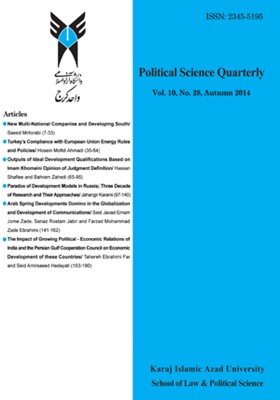New Multi-National Companies and Developing South
Subject Areas :
1 - Assistant Prof. at Kharazmi University
Keywords: New Multi-National Companies, Western Multi-national Companies, South- South Investment, Developing South, the New Methods of Direct Foreign Investment,
Abstract :
The role of multi-national companies on global capitalization and trade is a familiar phenomenon for developing issues and knowledgeable ones and international trade experts. The positive and negative effects of these companies’ activities on the current of developing in south have been focused by various intellectual ones and an extensive literature in this field has been produced. Nevertheless, has seen a new and growing kind of direct foreign investment that its origin is south countries and along this, a new kind of multi-national companies have been appeared that are named new multi-national companies. This paper is trying to examine the effects of these new players’ activities on the development view in south. This paper shows that the new multi-national companies have significant differences to western multi-national companies and the rise and developing activity area of these companies, from different aspects, is considered a positive change on the current of developing south low-paid countries. The main claim of this paper that is presented as a hypothesis is the new multinational companies in total have positive impact on the opportunities of attracting foreign investment as a result developing in south countries for increasing the volume of foreign investments in the world, giving variety to the methods of interesting and having more cultural similarities to south countries.
منابع فارسی
- استیگلیتز، جوزف (1386)، نگاهی نو به جهانی شدن، ترجمه مسعود کرباسیان، تهران: نشر چشمه.
- برنل، پیتر و ویکی رندال (1388)، مسائل جهان سوم، سیاست در جهان در حال توسعه، ترجمة احمد ساعی و سعید میرترابی، تهران: نشر قومس.
-خور،مارتین (1382)، جهانی شدن و جنوب، ترجمه احمد ساعی، تهران: نشر قومس.
- ساعی، احمد (1376)، درآمدی بر مسائل سیاسی و اقتصادی جهانی سوم، تهران: انتشارات سمت.
- کمیسیون جنوب (1376)، چالش جنوب (گزارش کمیسیون جنوب)، ترجمة ابراهیم خلیلی، تهران: نشر قومس.
- لارسون، توماس و دیوید اسکیدمور (1376)، اقتصاد سیاسی بینالملل، ترجمه احمد ساعی و مهدی تقوی، تهران: نشر قومس.
- هلد، دیوید و آنتونی مکگراو (1382)، جهانی شدن و مخالفان آن، ترجمه مسعود کرباسیان، تهران: انتشارات علمی و فرهنگی.
English Source
- Aggarwal, Raj and Jaya Prakash Pradhan (2010), “On the Globalness of Emerging Multinationals: A Study of Indian MNEs”, College of Business Administration, University of Akron, Sardar Patel Institute of Economic & Social Research.
- Aykut, Dilek and Andrea Goldestein (2006), Developiny Country Multinationals: South-South Investment Comes of Age, OECD Development Center Working Paper No.257.
-Aykut, D. and D. Ratha (2004), “South-South FDI Flows: How Big Are They?”, International Corporations, Vol.13, No.1, PP.149-176.
- Cho, Hyun-Dae and Lee Jae-Keun (2003), “The Developmental Path of Networking Capacity of Catch Up Players in Korea Semi-Conductor Industry”, R and D Management, Vol. 33, No.4, PP.411-423.
- Contessi, Silvio and Hoda El-Ghazaly (2010), “Multinationals from Emerging Economies, Growing but Little Understood”, The Regional Economist, July, at: http://www.stlouisfed.org
- Cross, A. and H. Tan (2004), “China and Round-Tripping Phenomenon”, miemo, Leeds University Business School, Center for Chinese Business and Development.
- Del Sol, P. (2005), “Why Join a Chilean Firm to Invest Elsewhere in Latin America?”, miemo, Pontificia Universidad Catolica de Chile, Santiago.
- Deng, P. (2004) “Outward Investment by Chinese MNCs: Motivations and Implications”, Business Horizons, 47(3): 8-16.
- Duning, J. H. (1998), “Third World Multinational Revised”, in: Dunning J.H. (ed), Globalization, Trade and foreign Direct Investment, Elsvier, Amesterdam.
Child, J. and Rodrigues, S., (2005), “The Internationalization of Chinese Firms: A Case for Theoretical Extension?”, Management and Organization Review 1, (3), pp. 381– 410.
- Economic Views (2010), Emerging Multinationals, at:
http://www.economics.pwc.com
- Erdilek, A. (2005), “Case Study on Outward FDI by Enterprises from Turkey”, Background Paper for the UNCTAD Conference on Enhancing The Production Capacity of Developing Country Firms Through Internationalization.
- FDI Intelligence (2010), Finacial Time LTd, PWC Analysis.
-Filippov, Sergey (2008) ,”RUSSIA’S EMERGING MULTINATIONALS: TRENDS AND ISSUES ”, United Nations University - Maastricht Economic and social Research and Training Centre on Innovation and Technology, Working Paper Series, 062.
- Gammeltoft, P. and et.al (2010), Emerging Multinationals, Emerging Theory, Journal of International Management.
- Gill, Anita (2012), “INTERNATIONALIZATION OF FIRMS FROM EMERGING ECONOMIES: THEORY, EVIDENCE AND POLICY”, Department of Distance Education, Punjabi University, Patiala 147002, India.
- Lecraw, D. (1977), “Direct Investment by Firms from Less Developed Countries”, Oxford Economic Papers, Vol.29, No.3, PP. 442-457.
- Levy E., U. Paniza and E. Stein, “The Cyclical Nature of Norht-South FDI Flow”, Inter-American Development Bank, Reserch Department Working Papers,2002, No.479.
-Mathews, J. A. (2002). “Dragon Multinationals: New Players in 21st Century
Globalization,” Asia Pacific Journal of Management, 23, pp. 5-27.
-Matthews, J. (2006), “Dragon Multinationals: New Players in 21st Century Globalization”, Asia Pacific J. Management,23: 5-27.
- Quer, Diego and et.al (2009), “China’s Outward foreign Direct Investment:
Driving Factors”, Theoretical Background and Strategic Implications”, Department of Management University of Alicante (Spain).
- Ramamurti, Ravi and Jithendra Singh (2008), (eds.), Emerging Multinationals from Emerying Markets, Cambridge: Cambridge University Press.
- Thompson, William and Rafael Reuveny (2010), Limits to Globalization, New York, Routleldge.
-Tonneson, Stein and Ashild Kolas (2006), Energy Security in Asia: China, India, Oil and Peace, Oslo, International Peace Research Institute.
-Vernon, R. (1966), “International Investment and International Trade in the Product Cycle”, Quarterly Journal of Economics, 80: 190–207.
- United Nations Conference on Trade and Development (2001, 2005, 2006, 2008, 2009, 2011), World Investment Report.

